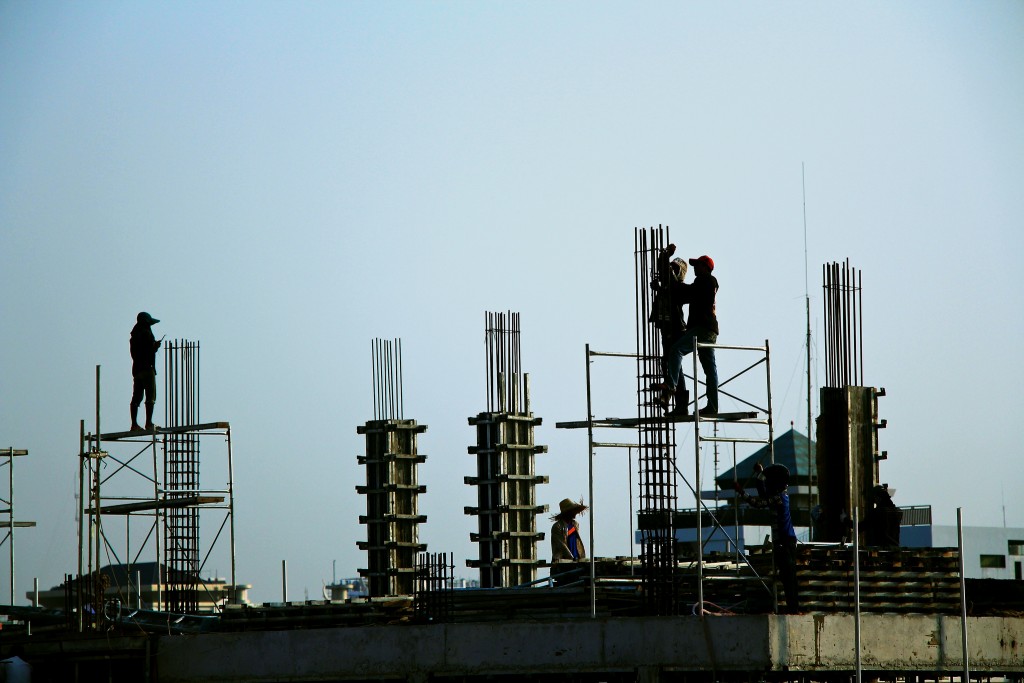
កម្មករកំពុងធ្វើការសាងសង់អគារមួយកន្លែង ក្នុងរាជធានីភ្នំពេញ នៃប្រទេសកម្ពុជា។ រូបភាព ថតដោយ Axel Drainville, ២៨ មករា ២០១៥។ ក្រោមអាជ្ញាប័ណ្ណ CC BY-NC-ND 2.0។
វិស័យឧស្សាហកម្ម
វិស័យឧស្សាហកម្មនៅកម្ពុជា (លើកលែង ឧស្សាហកម្មនិស្សារណកម្ម និងការរុករករ៉ែ) ភាគច្រើនសំដៅលើ វិស័យកាត់ដេរ កសិកម្ម សំណង់ និងទេសចរណ៍។
រាជរដ្ឋាភិបាលកម្ពុជា បានកំណត់ទិសដៅក្នុងការប្រែក្លាយប្រទេសកម្ពុជា ឲ្យក្លាយទៅជាប្រទេស ដែលមាន ប្រាក់ចំណូលមធ្យមក្នុងឆ្នាំ២០៣០ និងមានចំណូលខ្ពស់ក្នុងឆ្នាំ២០៥០ ដូចបានកំណត់ក្នុង ផែនការយុទ្ធសាស្ត្រអភិវឌ្ឍន៍ជាតិឆ្នាំ ២០១៤-២០១៨។ ទិសដៅនេះ បញ្ជាក់ពីតួនាទីនៃវិស័យឧស្សាហកម្ម និងសហគ្រាសធុនតូច និងមធ្យម ដែលជាកត្តាជំរុញដ៏សំខាន់ ចំពោះកំណើននាពេលអនាគត។1 កាលពីខែមីនា ឆ្នាំ២០១៥ រដ្ឋាភិបាល បានរៀបចំ និងអនុម័ត គោលនយោបាយអភិវឌ្ឍន៍វិស័យឧស្សាហកម្ម ដែលជាមគ្គុទេសក៍មួយ ដើម្បីផ្តល់នូវដំណោះស្រាយជាលក្ខណៈប្រព័ន្ធ ក្នុងការអភិវឌ្ឍវិស័យឧស្សាហកម្មឱ្យមានភាពប្រកួតប្រជែង នៅក្នុងប្រទេស កម្ពុជា។2
វិស័យឧស្សាហកម្មចំបងៗ រួមមាន វិស័យកាត់ដេរ និងកម្មន្តសាលធន់ស្រាល វិស័យសិប្បកម្មកែច្នៃម្ហូបអាហារ និងភេសជ្ជៈ វិស័យសំណង់ វិស័យអចលនទ្រព្យ វិស័យទេសចរណ៍ ព្រមទាំងវិស័យរុករករ៉ែ និងការរុករកផ្សេងៗទៀត ដែលកំពុងកើតមាន។ អង្គការ ទិនិន្នន័យអំពីការអភិវឌ្ឍ បានពិពណ៌នាអំពីការរុករករ៉ែ និងវិស័យរុករករ៉ែ ស្ថិតនៅក្រោម ឧស្សាហកម្មដែលអាចទាញយកបាន (សូមមើល ឧស្សាហកម្មនិស្សារណកម្ម សម្រាប់ព័ត៌មានលំអិតអំពីការរុករករ៉ែ)។
វិស័យកម្មន្តសាល
ចាប់ពីឆ្នាំ១៩៩៨ ដល់ ឆ្នាំ២០១៣ វិស័យកម្មន្តសាលមានចំនួន ២៤ ភាគរយ នៃផលិតផលក្នុងស្រុកសរុប (GDP) របស់ប្រទេសកម្ពុជា ហើយបានកើនឡើង ១២.៤ ភាគរយ ក្នុងមួយឆ្នាំ បើធៀបទៅនឹង វិស័យកសិកម្ម មានកំណើន ៤.៧ ភាគរយ និងវិស័យសេវាកម្មមាន ៨.៥ ភាគរយ។3 បណ្តុំវិស័យកម្មន្តសាលធន់ស្រាលរបស់កម្ពុជា ស្ថិតនៅជាចម្បង ប៉ុន្តែមិនផ្តាច់មុខ នៅក្នុងតំបន់សេដ្ឋកិច្ចពិសេស ដែលគ្របដណ្តប់ដោយប្រតិបត្តិការជាសំខាន់ផ្អែកលើកម្លាំងពលកម្ម។ រដ្ឋាភិបាល បានកត់សម្គាល់ឃើញថា វិស័យឧស្សាហកម្មនៅកម្ពុជា មានភាពទន់ខ្សោយនៅឡើយ ដោយសារមានមូលដ្ឋានតូចចង្អៀត បច្ចេកវិទ្យានៅមានកម្រិតទាប ការបែងចែកតម្លៃទាប និងការផ្តោតទៅលើតែវិស័យមួយចំនួនតូច។ ការផលិតសម្ភារសំណង់ គ្រឿងអេឡិចត្រូនិច គ្រឿងម៉ាស៊ីន ម៉ាស៊ីន និងផលិតផលគីមី មានទំហំតូចនៅឡើយ។4
វិស័យកាត់ដេរ នៅតែជាក្បាលម៉ាស៊ីនដ៏សំខាន់ ចំពោះកំណើនសេដ្ឋកិច្ច របស់ប្រទេសកម្ពុជា ដែលផ្តល់ការងារដល់មនុស្សចំនួន 605,129 នាក់ នៅក្នុងរោងចក្រកាត់ដេរ និងស្បែកជើងចំនួន 626 នៅចុងឆ្នាំ 2016 ។5 ការនាំចេញសរុបមានចំនួន 7,3 ពាន់លានដុល្លារក្នុងឆ្នាំ 2016 ដែលមានចំនួន 78% នៃការនាំចេញទំនិញរបស់កម្ពុជា។6 ប្រហែល 65% នៃសម្លៀកបំពាក់ និងស្បែកជើងបាននាំចេញទៅកាន់សហភាពអឺរ៉ុប និងសហរដ្ឋអាមេរិច ប៉ុន្តែការនាំចេញទៅកាន់ទីផ្សារដទៃទៀតក៏បានកើនឡើងយ៉ាងខ្លាំងដែរ។ ការនាំចេញទៅប្រទេសកាណាដាមានត្រឹមតែ 0,5 ភាគរយនៃការនាំចេញសរុបនៅក្នុងឆ្នាំ 2010 ប៉ុន្តែបានកើនឡើងដល់ 8 ភាគរយនៅឆ្នាំ 2016 ។ ការនាំចេញទៅប្រទេសជប៉ុនមានត្រឹមតែ 2,7 ភាគរយនៅក្នុងឆ្នាំ 2010 ប៉ុន្តែបានកើនឡើងដល់ 9 ភាគរយនៅឆ្នាំ 2016. ប្រទេសចិនគឺជាវិនិយោគបរទេសដ៏សំខាន់នៅក្នុងរោងចក្រសំលៀកបំពាក់និងស្បែកជើងនៅកម្ពុជា។7
វិស័យកសិកម្ម
នៅកម្ពុជា វិស័យកសិកម្ម បានចូលរួមចំណែកដល់ផលិតផលក្នុងស្រុកសរុប (GDP) ប្រមាណ ៣៦ ភាគរយ ក្នុងឆ្នាំ២០១៣។ ប៉ុន្តែក្នុងឆ្នាំ១៩៩៣ ផលិតកម្មកែច្នៃម្ហូបអាហារ និងភេសជ្ជៈ បានធ្លាក់ចុះពី ៣២.៧ ភាគរយ ដល់ ១០ ភាគរយ ក្នុងអំឡុងឆ្នាំ ២០០៨ ដល់ ២០១២។8 ជាផ្នែកមួយនៃគោលនយោបាយរបស់រាជរដ្ឋាភិបាល ក្នុងការគាំទ្រដល់ឧស្សាហកម្មកសិកម្ម សម្ភារៈ និងឧបករណ៍ប្រើប្រាស់ក្នុងផលិតកម្មកសិកម្ម មិនត្រូវបានគិតពីពន្ធនាំចូលនោះឡើយ។ រាជរដ្ឋាភិបាល សង្ឃឹមថាគោលនយោបាយទាំងនេះ នឹងបង្កើនការនាំចេញអង្ករពី ៣៧៩,០០០ តោនទៅ ១ លានតោន នៅឆ្នាំ២០១៥។9 ម៉ាស៊ីនកិនស្រូវ កំពុងក្លាយជាឧស្សាហកម្មមួយ ដែលលេចរូបរាងឡើង។
វិស័យអចលនទ្រព្យ
ប្រទេសកម្ពុជា កំពុងមានការរីកចំរើនខាងវិស័យអចលនទ្រព្យ។ យោងតាមរបាយការណ៍ របស់ធនាគារពិភពលោក វិស័យសំណង់ បានដើរឈានមុខ វិស័យកសិកម្ម និងទេសចរណ៍ ដោយបានក្លាយជាចលករកំណើនធំបំផុតទីពីរ នៅក្នុងឆ្នាំ២០១៤។ កំណើននេះ បានឆ្លុះបញ្ចាំងពីទំហំទឹកប្រាក់ចំនួន ២.៥ ពាន់លាន ដុល្លារសហរដ្ឋអាមេរិក ទៅលើការសាងសង់ ដែលត្រូវបានសម្រេចអនុញ្ញាតដោយ ក្រសួងដែនដី នគរូបនីយកម្ម និងសំណង់ ហើយការវិនិយោគលើទ្រព្យសកម្មថេរ មានចំនួន ២៥៨ លានដុល្លារសហរដ្ឋអាមេរិក នៅក្នុងវិស័យទេសចរណ៍ ដែលត្រូវបានអនុម័តដោយក្រុមប្រឹក្សាអភិវឌ្ឍន៍កម្ពុជា។10 ប៉ុន្តែ កង្វះបទប្បញ្ញត្តិក្នុងវិស័យសំណង់នេះ នៅតែជាក្តីបារម្ភ។11
វិស័យទេសចរណ៍
វិស័យទេសចរណ៍ គឺជាវិស័យសំខាន់ ហើយកំពុងរីកលូតលាស់នៅកម្ពុជា។ វិស័យទេសចរណ៍ រួមចំណែក (ដោយផ្ទាល់ និងដោយប្រយោល) ១ភាគ៣ នៃផលិតផលក្នុងស្រុកសរុប (GDP)។ នៅក្នុងឆ្នាំ២០១៤ វិស័យនេះ រួមចំណែកបង្កើតការងារដោយផ្ទាល់ប្រមាណ ១១ ភាគរយ ដោយបានបង្កើតការងារចំនួន ៩៨៥,៥០០ នៅក្នុងទេសចរណ៍ និងការធ្វើដំណើរ ហើយការបង្កើតការងារដោយប្រយោល ត្រូវបានប៉ាន់ប្រមាណថាមាន ២.២ លាន។12
ធ្វើបច្ចុប្បន្នភាពចុងក្រោយ៖ ១៥ តុលា ២០១៥
ឯកសារយោង
- 1. ក្រសួងផែនការ. “ផែនការយុទ្ធសាស្ត្រអភិវឌ្ឍន៍ជាតិឆ្នាំ ២០១៤-២០១៨.” ដកស្រង់ ២៣ កញ្ញា ២០១៥. http://countryoffice.unfpa.org/cambodia/drive/NSDP2014-2018.pdf
- 2. ទីស្តីការគណៈរដ្ឋមន្ត្រី. “គោលនយោបាយអភិវឌ្ឍន៍ឧស្សាហកម្ម ឆ្នាំ ២០១៥-២០២៥.” ដកស្រង់ ២៣ កញ្ញា ២០១៥. www.cambodiainvestment.gov.kh/content/uploads/2015/09/IDP-English-Version-FINAL1.pdf
- 3. ដូចលេខយោងខាងលើ
- 4. ដូចលេខយោងខាងលើ
- 5. អង្គការពលកម្មអន្តរជាតិ. ព្រឹត្តិបត្រព័ត៌មានវិស័យកាត់ដេរនិងស្បែកជើងនៅកម្ពុជា លេខ 6 ។ បោះពុម្ពខែ ឧសភា ឆ្នាំ២០១៧។ ចូលអានថ្ងៃទី២៨ ខែមិថុនា ឆ្នាំ២០១៧។ http://ilo.org/wcmsp5/groups/public/—asia/—ro-bangkok/documents/publication/wcms_555290.pdf
- 6. ដូចឯកសារយោងខាងដើម
- 7. ដូចឯកសារយោងខាងដើម
- 8. វិទ្យាស្ថានជាតិស្ថិតិ. (២០១៣). ដកស្រង់ចេញពី “គោលនយោបាយអភិវឌ្ឍន៍ឧស្សាហកម្ម ២០១៤-២០២៤ (ពង្រាង)”, បានបង្ហោះនៅលើ គេហទំព័រ Sciaroni & Associates. www.sa-asia.com/home/alert_perspective/pdf/industrial_development_policy_2014to2024.pdf
- 9. ក្រសួងការបរទេសអាមេរិក. (២០១៤). “សេចក្តីថ្លែងការណ៍ពីបរិយាកាសវិនិយោគ ឆ្នាំ២០១៤.” ដកស្រង់ ៩ មករា ២០១៥. https://2009-2017.state.gov/documents/organization/228917.pdf
- 10. ដូចលេខយោងខាងលើ
- 11. កង សុធា និង George Styllis. “កង្វះខាតនូវនិយ័តកម្មសំណង់ ជាការព្រួយបារម្ភមួយ,” ខេមបូឌាដេលី, ២ តុលា ២០១៤. ដកស្រង់ ៩ មករា ២០១៥. www.cambodiadaily.com/business/lack-of-construction-regulations-a-concern-68862/
- 12. ទេសចរណ៍ពិភពលោក និង ក្រុមប្រឹក្សាទេសចរណ៍. “ការធ្វើដំណើរទេសចរ និងវិស័យទេសចរណ៍៖ ឥទ្ធិពលផ្នែកសេដ្ឋកិច្ចឆ្នាំ ២០១៥.” ដកស្រង់ ១៥ តុលា ២០១៥. www.wttc.org/-/media/files/reports/economic%20impact%20research/countries%202015/cambodia2015.pdf

